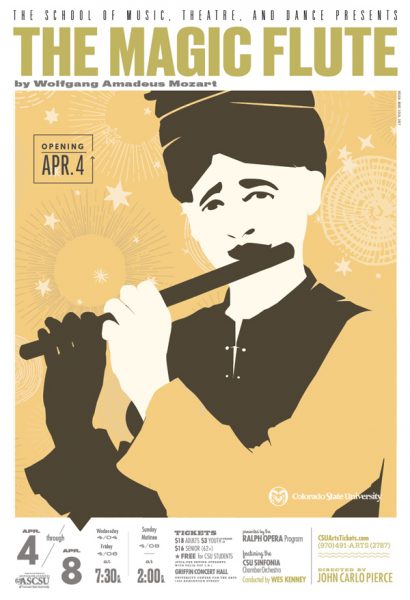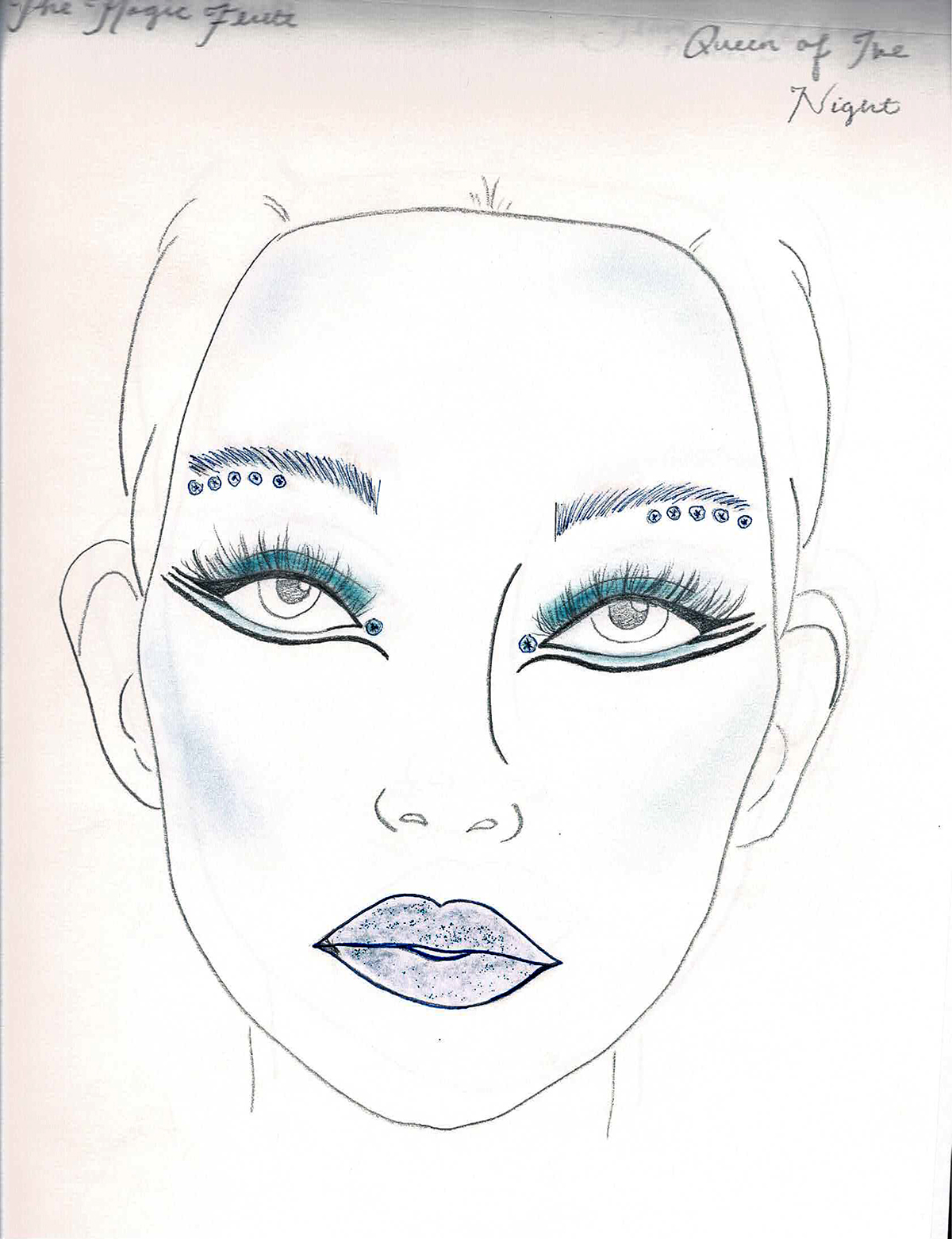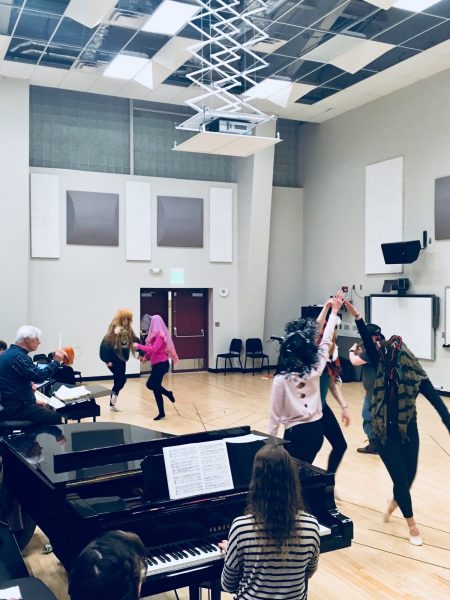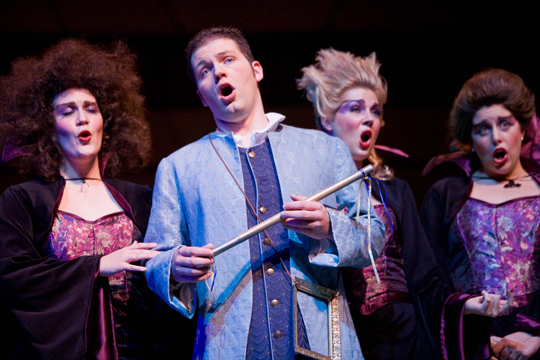Die Zauberflöte, German for “The Magic Flute,” is a classic opera making its way to the Griffin Concert Hall stage during the first week of April. The CSU Ralph Opera Program is delighted to perform this fan-favorite by Wolfgang Amadeus Mozart.
The premiere of Die Zauberflöte took place in Germany in Sept. of 1791, and has appeared in countless theatres around the world ever since. Mozart and librettist Emanuel Schikaneder collaborated to create this fairy-tale “Singspiel,” inspired by medieval literature, romance novels, other popular operas, and even Freemasonry. This romantic allegory, with enlightened themes of truth, nobility, and love, pairs mythology with the rich instrumental and vocal music of Mozart.
 The Story
The Story
The Magic Flute is an opera in two acts set in the Middle East. In the first act, Prince Tamino faints while trying to escape from a serpent. Three ladies from The Queen of the Night’s realm save him and take him to the kingdom. The bird catcher, Papageno, is present when Tamino awakens and is presumed to be the one who saved him from the serpent, but eventually the three ladies explain what happened.
The Prince is given a picture of The Queen of the Night’s daughter Pamina, and for Tamino, it is love at first sight; however, Pamina is a prisoner of the high priest Sarastro. Tamino is determined to rescue Pamina, and The Queen of the Night promises that if he is successful, he has permission to marry her. Papageno agrees to follow Tamino on his journey, and the pair are provided a magic flute and magical bells to protect them, as well as three spirits to guide them. Papageno encounters the Princess and informs her that the Prince is coming to rescue her when they are suddenly discovered by Sarastro. Although frightened at first, Tamino and Papageno find him to be gentle and kind and Sarastro challenges Tamino with trials to prove he is worthy of the Princess’ hand.
The second act begins with Sarastro’s admission that he kidnapped Pamina from the evil queen because he knew a worthy match would save her, and eventually marry her. He explains that they are destined to be together so long as Tamino can successfully complete the trials. Sarastro promises Papageno that he too will have a wife in the end. The Queen of the Night sneakily tries to intervene and convince Pamina to kill Sarastro.
Tamino’s first trial is not to speak at all, and when he refuses to converse with Pamina, she believes he does not love her. The three spirits explain Sarastro’s rules, and with the help of the magic flute, Tamino successfully completes the additional trials of water and fire.
Papageno meets his Papagena while experimenting with the magic bells, and the two perform their famous ‘pa-pa-pa’ duet in celebration. However, The Queen of the Night is not thrilled with the happiness of those around her and attempts to destroy Sarastro’s kingdom and everyone inside. She is unsuccessful and is banished to darkness. Tamino receives Pamina’s hand in marriage as promised, and the enlightened characters live happily ever after.
Collaboration is Key
The presentation of The Magic Flute is directed by Dr. John Carlo Pierce, assistant professor of voice, and conducted by Professor Wes Kenney, director of orchestras. The cast consists of 30 opera students 38 student instrumentalists in the CSU Sinfonia, and five dancers; the entire performance is run by CSU Theatre practicum students, including the stage management and crew.
The lead role of Prince Tamino is double-cast by opera students Christian Gibbs and Luke Thatcher. The role of Pamina is played by YounWoo Seo, Papageno is played by Jonathan Wilson, Hayley Voss is playing The Queen of the Night, and Sarastro is played by Dominic Aragon.
Dr. Pierce believes CSU’s version of The Magic Flute is unique because of the cast. “Every singer brings some of him or herself to the role, and the bringing together of these interpretations keeps operas in the standard repertoire fresh and new,” he said. “I myself have performed the role of Prince Tamino several times, and yet both Gibbs and Thatcher have their own take on the role. We work from the same manual and yet build something unique,” he continued. In fact, Dr. Pierce recalls his fondness for Tamino’s first aria, “Dies Bildnis ist bezaubernd schön,” where the Prince professes his undying love.
As director, Dr. Pierce’s stylistic approach to The Magic Flute is “fairly classic.” However, the integration of projections adds a contemporary element to the performance. He enjoys collaborating with other areas within the School of Music, Theatre, and Dance as building unique relationships within the department is one of his favorite parts of being the director.
At the same time, Maestro Kenney enjoys working with students and colleagues on opera repertoire. “John Carlo Pierce is doing a great job as director and Chris Reed has coached all the vocalists in the eighteenth century vocal style. This makes my job of pulling forces together much easier.”
The opera students began working with Pierce and Reed on material for The Magic Flute last semester, eventually piecing together the opera in rehearsals called a “sitzprobe.” This is a process where the vocalists, the orchestra, and dancers come together to walk through the performance, making adjustments along the way.
Professor Kenney particularly enjoys the finale of Act I saying, “It is one of the longest recitatives in the repertoire and I teach challenging operas twice a year to the students…Hard to say if there is a favorite [part of The Magic Flute] since there is so much wonderful music!”
According to Kenney, audiences love The Magic Flute so much because the opera is rich in characters with whom people can easily identify. “There are equal amounts of comedy, tragic circumstances, and mystery. It also holds interest because of the revelations about the masons, something that caused Mozart to get in trouble,” said Kenney in reference to the debated symbolism the two Freemasons – Mozart and Schikaneder – supposedly worked into the opera.
Mozart is challenging to execute because the composer did not leave any formal instructions or recommendations on how to present his compositions. “To perform this opera in the style of the eighteenth century means that we have to remove all musical approaches that came after that, from Beethoven to Beyoncé. Easier said than done no doubt, but when done correctly, it makes for a spellbinding experience,” Kenney revealed.


A Look Inside the Wardrobe
The costumes for The Magic Flute are designed and hand-crafted by members of the CSU Costume Shop. Costume Shop Cutter/Draper, Kate Mathis, and her student assistant designers, James Arnold and Laura Myers, spent countless hours researching costume concepts to design the perfect ensemble for each character. The hair and makeup for the production is designed by student Kaia Heer. Mathis enjoys many aspects of the process but admits that her favorite part of designing costumes is the research. She spends a minimum of 80 hours doing research to develop designs that best fit the theme of each opera at CSU, as well as compliment the personality of each character.
“I can spend hours looking for images that perfectly communicate the character. I love the element of assigning the choice to the character. The designs don’t have to be to my personal taste, they don’t have to be something I would personally wear, they have to communicate the character and support the action of the production, and there’s a freedom in that.”
Mathis’ design goal for this production is to “support the message of the show, which is all about nobility, sacrifice, and love.” Because the traditional setting for The Magic Flute is ancient Egypt, Mathis wanted to stay true to the North African/Middle Eastern feel for the costumes, but with her personal touch. Much of her inspiration was influenced by illustrators from the 1910s, including Edmund Dulac, Virginia Frances Sterrett, and Kay Nielsen, as well the famous Ballets Russes’ designer, Leon Bakst. Mathis loves their use of Persian themes, jewel-tones, bold patterns, and strong graphics.
Mathis’ favorite characters to design for in The Magic Flute are Papageno, Papagena. “They’re very much the comedic relief, and so I’ve gotten to take those designs to a really fun, silly place,” she said. “The Princess is also one I have really enjoyed working on. She’s turned into this really sweet ingénue, almost doll-like look, and I think it’s just adorable,” she elaborated.
Makeup Designer Kaia Heer worked closely with Mathis to create cohesive designs. She explained the color schemes for the opera as “cool tones,” including deep blues, and royal purples for The Queen of the Night and the characters from her kingdom. She went for warmer oranges, reds, and yellows for Sarastro and his followers. “This show is so great from a design point because it allows us to get really creative with color,” she expressed.
After researching the opera, Heer picked things she wanted to highlight for each character to drive her designs. “Each character serves a different purpose and is a different entity, so I really try to take my time with each one and design them in a way [that] fits within their own story,” Kaia explained about the process that included collaboration with the other designers, talking through concepts until everyone was on the same page.
Heer’s favorite characters to design were The Queen of the Night and Papagena. “Those two are really loud and creative, and as an artist, that kind of license is amazing,” she exclaimed!
 Music Through Movement
Music Through Movement
The Magic Flute has passages where dancers portray different character groups: two scenes as temple servants, one scene as animals entranced by Tamino’s magic flute, and in the last scene as birds during Papageno’s aria. The dance sections are choreographed and staged by Senior Dance Major Shannon Gerney, and the performers are dance majors Katelyn Doyle, Avery Jones, Madison Martinek, Jenny Trenchard, and Julianna Williams.
During the animal scene, Gerney encouraged her dancers to take a literal mindset and “find ways of moving their human bodies to evoke the essence of the animal they are portraying.” The dancers are en pointe during the bird scene, and use balletic movements to portray the movement of a bird, as well as the “twinkling” of Papageno’s bells, Gerney explained.
The dancers wear different costumes for each character, wearing large head pieces throughout the performances. The dancers wear masks designed by the CSU Costume Shop for the enchanted animal scene, which Gerney describes as “elegant and expressive and they help the dancers feel like the characters they are portraying.”
For Gerney, the process of choreographing for the opera is different than for a dance concert. “For CSU dance concerts we have access to our theater far in advance as it is one of our classrooms…for the opera, we have been rehearsing in a rehearsal room with taped floors [to] designate the set,” she explained. To maintain a connection between the dancers and vocalists, as well as making sure the vocalists can be clearly seen, Gerney has made adjustments to formations, dance movements, and interactions with the vocalists based on where they are on stage. “Having the opportunity to explore movement that is appropriate for storytelling and allowing it to be literal helps guide the audience on the journey of The Magic Flute,” Gerney elaborated.
Working with the Ralph Opera Program and the Sinfonia has been a unique experience for Gerney, allowing her to share her passion with other groups of performing artists, as well as expand choreography beyond the dance settings she’s used to. “It has been such an honor to work with another group of talented performers and join them in rehearsals as they prepare to share their gift with the audience and we prepare to share ours,” she said.
Meet the Leads
Student vocalists Luke Thatcher and Christian Gibb play the role of Tamino, performing on alternating nights in The Magic Flute. For Thatcher, this is his first time as a lead role in an opera and he describes the experience as intense, yet extremely rewarding. “Tamino is this guy who is going out and finding the truth within himself, the truth in the world, and when he finds the picture of Pamina, he’s wondering if he’s found what he’s looking for,” Thatcher explained, relating to Tamino’s search for truth and love. “As my interpretation of Tamino, that’s when I could put [in] my real-life experiences, of what my first experience of love felt like, and what my first crush was like. I knew that it was that tense moment that I could put into my main aria ‘Dies Bildnis ist bezaubernd schön,’” he revealed.
Student vocalist YounWoo Seo plays the role of Pamina and describes her character as a cute, smart, honest, and strong woman who expresses feelings of love and fear throughout the opera. She explains how her young character is fearful of Sarastro’s intentions but mature enough to feel love for Tamino, all while remaining loyal and honest throughout the story. “There are many exciting things happening during this opera, and I’m excited to show off my musical abilities during the performance,” Seo expressed.
The Magic Flute is an opera filled with excitement, humor, and mystery as well as beautiful singing and dancing. The performance takes place on April 4 and 6 at 7:30 p.m., and April 8 at 2 p.m. in the Griffin Concert Hall.
Ticket Information
Tickets for the performance are no charge for Full-fee paying CSU students, $3 for youth (under 18), and $12 for seniors (62+), and $14 for adults. Tickets are available at the University Center for the Arts (UCA) ticket office in the UCA lobby Monday through Friday, 3:30-5:30 p.m. and 60 minutes prior to performances, by phone at (970) 491-ARTS (2787), or online at csuartstickets.com.


